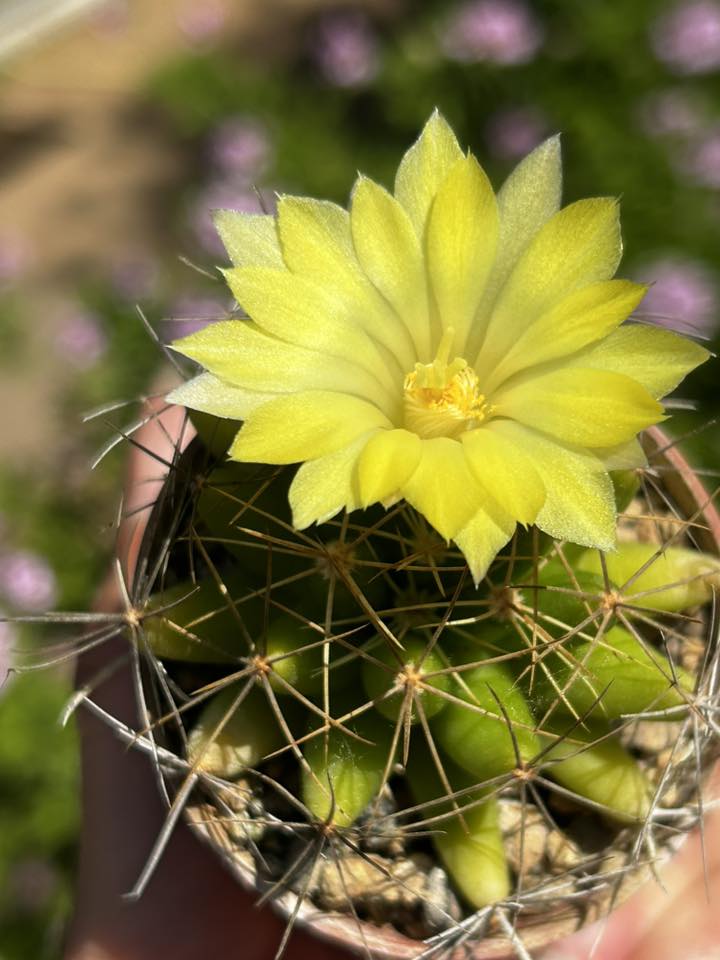🌵✨ Mammillaria longimamma — The Finger Mammillaria Cactus
Mammillaria longimamma, commonly known as Finger Mammillaria or Long-Nipple Cactus, is a distinctive species in the Mammillaria genus, native to central Mexico. Its name ‘longimamma’ means ‘long nipple’, referring to the plant’s unusually long, finger-like tubercles (protrusions) — a unique feature compared to other Mammillarias.
This cactus is favored among collectors for its uncommon shape, stunning yellow flowers, and relatively easy care requirements, making it an excellent choice for succulent and cactus enthusiasts.
🌵 Botanical Overview
Scientific Name: Mammillaria longimamma
Family: Cactaceae
Origin: Central Mexico (Hidalgo and Querétaro)
Common Names: Long-Nipple Cactus, Finger Mammillaria
Growth Habit: Clumping, globular to slightly elongated stems
Size:
Individual heads: 4 to 8 cm tall (1.5 to 3 inches)
Spread: Can form clusters up to 30 cm (12 inches) wide
🍃 Appearance
Stems:
Spherical to slightly cylindrical, green
Covered in long, conical tubercles that give a finger-like appearance
Spines:
Each tubercle has a central spine surrounded by several radial spines
Spines are white to pale yellow, thin, and flexible
Flowers:
Large, bright lemon-yellow flowers
Bloom from late spring to early summer
Flowers are funnel-shaped and appear at the top of the stems
Can reach up to 4 cm in diameter, large relative to the plant’s size
The combination of unusual tubercles and vivid flowers makes this cactus a standout in any collection.
☀️ Light Requirements
Indoors:
Prefers bright, direct sunlight for at least 4-6 hours per day
A south-facing window is ideal
Supplemental grow lights can help in darker spaces
Outdoors:
Thrives in full sun to light shade
In very hot regions, provide light afternoon shade to prevent scorching
Adequate light ensures compact growth and promotes flowering.
🌡️ Temperature & Humidity
Temperature:
Prefers warm conditions: 20–30°C (68–86°F)
Can tolerate higher temperatures if kept dry
Not frost-tolerant — minimum temperature 5°C (41°F)
Humidity:
Best in dry, arid conditions
High humidity can increase the risk of fungal infections
Provide good air circulation to reduce moisture accumulation around the plant.
💧 Watering Routine
Spring to Autumn (Active Growth):
Water when the soil is completely dry
Usually every 10–14 days, but may vary based on temperature and humidity
Water deeply but ensure complete drainage
Winter Dormancy:
Water very sparingly or not at all, especially if kept cool
Excess water during winter can cause root rot
🚫 Important: Avoid watering directly into the tubercles or crown, as trapped water can lead to rot.
🌱 Soil Requirements
Type:
Needs well-draining cactus or succulent soil
Recommended mix:
50% cactus soil
25% perlite or pumice
25% coarse sand or small gravel
pH: Slightly acidic to neutral (6.0–7.0)
🌾 Fertilizing
Fertilize during the growing season (spring-summer):
Use a low-nitrogen cactus fertilizer (e.g., 5-10-10 NPK)
Apply once a month, diluted to half strength
No feeding needed during winter dormancy.
✂️ Maintenance and Pruning
Pruning: Not generally needed except to remove:
Dead flowers
Dried or damaged tubercles
Pests:
Watch for:
Mealybugs
Spider mites
Scale insects
Treat with insecticidal soap or neem oil
Diseases:
Prone to root rot if overwatered
Ensure soil is well-draining and avoid humidity buildup
🌱 Propagation
Offsets (Pups):
Produces small offsets around the base
Remove with a clean, sharp knife when they are sizable
Let offsets callous for 2–3 days, then plant in dry cactus soil
Seeds:
Can propagate via seeds, though it is a slower process
Sow seeds on the surface of well-draining soil
Keep slightly moist until germination
Propagation by offsets is the quickest and easiest method for home growers.
🛡️ Common Problems
Root Rot: From overwatering or poor drainage
Sunburn: In very intense direct sun without acclimation
Pest Infestation: Especially if air circulation is poor
🎍 Decorative & Practical Uses
Ideal for:
Rock gardens
Windowsill displays
Container gardens
Cactus collections
Its eye-catching flowers and tubercled form make it a showpiece among other small cacti.
✅ Conclusion
Mammillaria longimamma is a charming and easy-to-grow cactus for both beginners and seasoned collectors. With proper sunlight, watering care, and a gritty substrate, it will thrive and reward you with vivid yellow flowers and distinctive textures.





Reviews
There are no reviews yet.